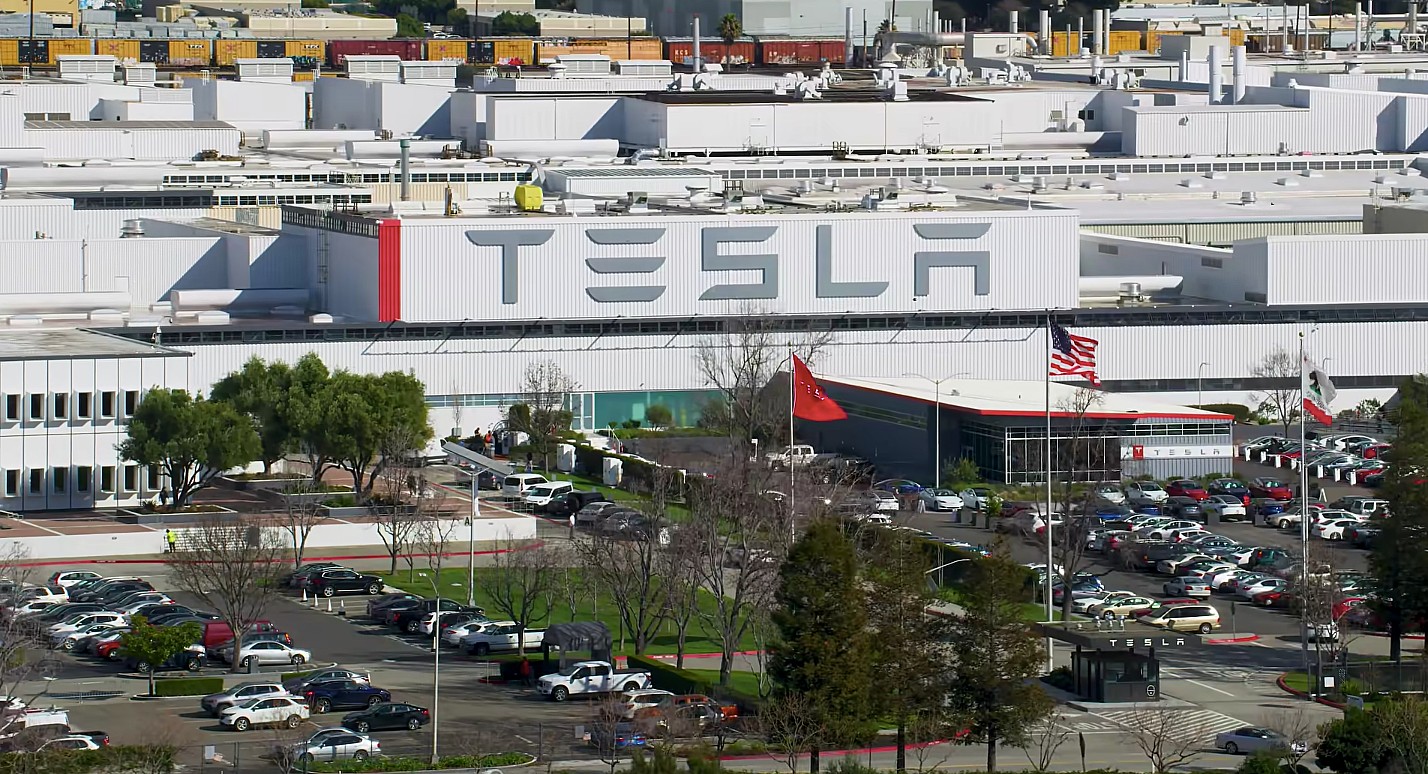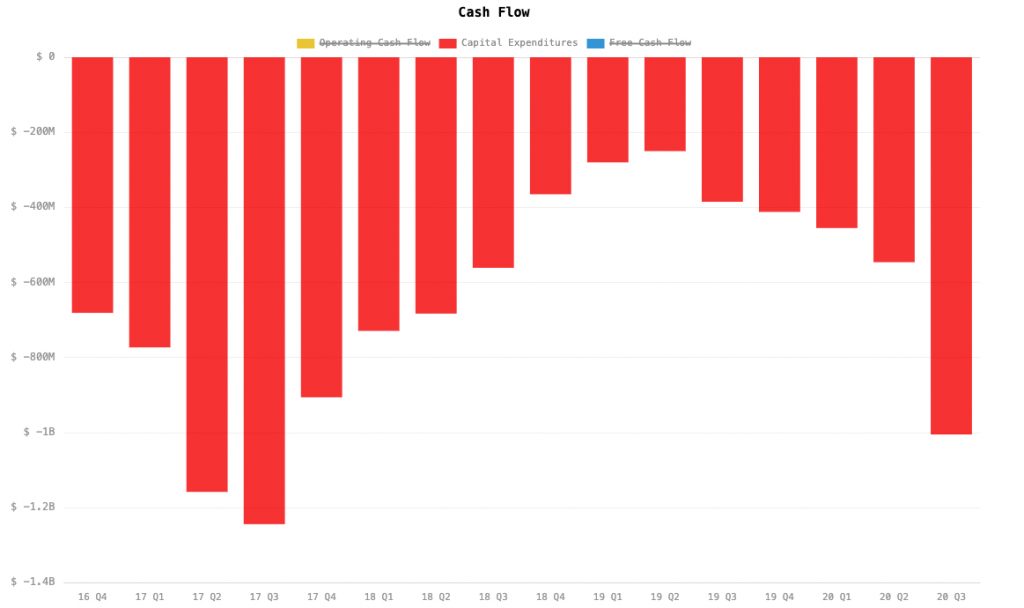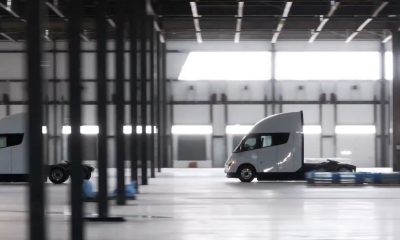

Investor's Corner
Tesla’s CAPEX efficiencies could pave the way for a fleet of ‘Alien Dreadnought’ factories
Tesla’s (NASDAQ:TSLA) Q3 10-Q Form for 2020 provided some interesting tidbits about the electric car maker’s plans for the coming years. Among these is the fact that the company is planning to increase its capital expenditures to about $4.5 to $6.0 billion in the next two fiscal years. These would be the highest expenditures that the company would be spending on its projects yet, with the amount rivaled only by 2017, when Tesla was dealing with the Model 3 ramp.
“Owing and subject to the foregoing as well as the pipeline of announced projects under development and all other continuing infrastructure growth, we currently expect our capital expenditures to be at the high end of our range of $2.5 to $3.5 billion in 2020 and increase to $4.5 to $6.0 billion in each of the next two fiscal years,” Tesla wrote.
While Tesla’s 10-Q Form noted that CAPEX will be higher than ever in the next couple of years, the company’s estimates still suggest that it has reached an incredible level of efficiency in terms of its expenses. It makes sense for Tesla’s CAPEX to be higher than it ever was, after all, since the company will be making more vehicles than ever before, and it would also be building factories in Berlin, Shanghai, and Texas. The company will be ramping its battery cell production capabilities as well.

As noted by Galileo Russell of YouTube’s Hyperchange channel, Tesla’s expectations for its CAPEX in 2021 and 2022 suggest that the electric car maker has become about five times more efficient on spending per unit of vehicle production compared to 2017. Interestingly enough, Elon Musk responded to the Tesla investor’s observations, lightly noting on Twitter that the company’s CAPEX efficiency back in 2017 was “trash.”
A look at Tesla’s capital expenditures over the years shows that Musk was telling the brutal truth. Back in 2017, Tesla’s CAPEX peaked at about $1.2 billion in one quarter as the company was launching the Model 3 in the Fremont Factory. Today, Tesla’s CAPEX has not broken this record, despite the electric car maker undergoing the Model Y ramp, the buildout of Gigafactory Shanghai, Giga Berlin, and Giga Texas, as well as an expansion of its battery production capabilities.
With this in mind, capital expenditures of $4.5 to $6.0 billion annually within the next two fiscal years seem to be a steal. This was mentioned by Russell on Twitter, and Musk responded by stating that the Tesla team has done excellent work over the years to make such progress possible.
What is rather remarkable is that Tesla is nowhere near done in the optimization of its operations. Over the years, and as the company attempts to hit its goal of producing millions of vehicles annually, there is a pretty good chance that Tesla would still improve and optimize its capital expenditures further. This would work in the company’s favor, especially as it attempts to build more factories and start the production of its upcoming electric vehicles like the Cybertruck, Semi, and the highly-anticipated $25,000 car.
If Tesla could accomplish these, the company would likely end up mastering the art of building electric car factories in a way that is frighteningly quick and capital-efficient, much like how it mastered the mass production of premium electric cars like the Model 3. This goes in line with Elon Musk’s statement back in July, when he noted on Twitter that the “Gigafactory is the product even more than the car.” The fact that every Tesla facility seems to be larger and more optimized than its predecessor highlights this idea.
During Battery Day, Elon Musk and Drew Baglino remarked that Tesla would need to produce an insane amount of batteries to achieve its goal of accelerating the advent of sustainable energy. This requires the company to build numerous factories at a rate that’s higher than ever before. With this in mind, there seems to be a good chance that Elon Musk’s “Alien Dreadnought” concept may see a resurgence in the near future. With a lineup of hyper-advanced factories that produce clean energy products at an optimal cost, after all, Tesla’s upcoming facilities may very well be considered as fleet of extraterrestrial machines that build machines.
Watch a discussion of Tesla’s CAPEX efficiency improvements in the video below.
Investor's Corner
Tesla could save $2.5B by replacing 10% of staff with Optimus: Morgan Stanley
Jonas assigned each robot a net present value (NPV) of $200,000.

Tesla’s (NASDAQ:TSLA) near-term outlook may be clouded by political controversies and regulatory headwinds, but Morgan Stanley analyst Adam Jonas sees a glimmer of opportunity for the electric vehicle maker.
In a new note, the Morgan Stanley analyst estimated that Tesla could save $2.5 billion by replacing just 10% of its workforce with its Optimus robots, assigning each robot a net present value (NPV) of $200,000.
Morgan Stanley highlights Optimus’ savings potential
Jonas highlighted the potential savings on Tesla’s workforce of 125,665 employees in his note, suggesting that the utilization of Optimus robots could significantly reduce labor costs. The analyst’s note arrived shortly after Tesla reported Q2 2025 deliveries of 384,122 vehicles, which came close to Morgan Stanley’s estimate and slightly under the consensus of 385,086.
“Tesla has 125,665 employees worldwide (year-end 2024). On our calculations, a 10% substitution to humanoid at approximately ($200k NPV/humanoid) could be worth approximately $2.5bn,” Jonas wrote, as noted by Street Insider.
Jonas also issued some caution on Tesla Energy, whose battery storage deployments were flat year over year at 9.6 GWh. Morgan Stanley had expected Tesla Energy to post battery storage deployments of 14 GWh in the second quarter.
Musk’s political ambitions
The backdrop to Jonas’ note included Elon Musk’s involvement in U.S. politics. The Tesla CEO recently floated the idea of launching a new political party, following a poll on X that showed support for the idea. Though a widely circulated FEC filing was labeled false by Musk, the CEO does seem intent on establishing a third political party in the United States.
Jonas cautioned that Musk’s political efforts could divert attention and resources from Tesla’s core operations, adding near-term pressure on TSLA stock. “We believe investors should be prepared for further devotion of resources (financial, time/attention) in the direction of Mr. Musk’s political priorities which may add further near-term pressure to TSLA shares,” Jonas stated.
Investor's Corner
Two Tesla bulls share differing insights on Elon Musk, the Board, and politics
Two noted Tesla bulls have shared differing views on the recent activities of CEO Elon Musk and the company’s leadership.

Two noted Tesla (NASDAQ:TSLA) bulls have shared differing views on the recent activities of CEO Elon Musk and the company’s leadership.
While Wedbush analyst Dan Ives called on Tesla’s board to take concrete steps to ensure Musk remains focused on the EV maker, longtime Tesla supporter Cathie Wood of Ark Invest reaffirmed her confidence in the CEO and the company’s leadership.
Ives warns of distraction risk amid crucial growth phase
In a recent note, Ives stated that Tesla is at a critical point in its history, as the company is transitioning from an EV maker towards an entity that is more focused on autonomous driving and robotics. He then noted that the Board of Directors should “act now” and establish formal boundaries around Musk’s political activities, which could be a headwind on TSLA stock.
Ives laid out a three-point plan that he believes could ensure that the electric vehicle maker is led with proper leadership until the end of the decade. First off, the analyst noted that a new “incentive-driven pay package for Musk as CEO that increases his ownership of Tesla up to ~25% voting power” is necessary. He also stated that the Board should establish clear guidelines for how much time Musk must devote to Tesla operations in order to receive his compensation, and a dedicated oversight committee must be formed to monitor the CEO’s political activities.
Ives, however, highlighted that Tesla should move forward with Musk at its helm. “We urge the Board to act now and move the Tesla story forward with Musk as CEO,” he wrote, reiterating its Outperform rating on Tesla stock and $500 per share price target.
Tesla CEO Elon Musk has responded to Ives’ suggestions with a brief comment on X. “Shut up, Dan,” Musk wrote.
Cathie Wood reiterates trust in Musk and Tesla board
Meanwhile, Ark Investment Management founder Cathie Wood expressed little concern over Musk’s latest controversies. In an interview with Bloomberg Television, Wood said, “We do trust the board and the board’s instincts here and we stay out of politics.” She also noted that Ark has navigated Musk-related headlines since it first invested in Tesla.
Wood also pointed to Musk’s recent move to oversee Tesla’s sales operations in the U.S. and Europe as evidence of his renewed focus in the electric vehicle maker. “When he puts his mind on something, he usually gets the job done,” she said. “So I think he’s much less distracted now than he was, let’s say, in the White House 24/7,” she said.
TSLA stock is down roughly 25% year-to-date but has gained about 19% over the past 12 months, as noted in a StocksTwits report.
Investor's Corner
Cantor Fitzgerald maintains Tesla (TSLA) ‘Overweight’ rating amid Q2 2025 deliveries
Cantor Fitzgerald is holding firm on its bullish stance for the electric vehicle maker.

Cantor Fitzgerald is holding firm on its bullish stance for Tesla (NASDAQ: TSLA), reiterating its “Overweight” rating and $355 price target amidst the company’s release of its Q2 2025 vehicle delivery and production report.
Tesla delivered 384,122 vehicles in Q2 2025, falling below last year’s Q2 figure of 443,956 units. Despite softer demand in some countries in Europe and ongoing controversies surrounding CEO Elon Musk, the firm maintained its view that Tesla is a long-term growth story in the EV sector.
Tesla’s Q2 results
Among the 384,122 vehicles that Tesla delivered in the second quarter, 373,728 were Model 3 and Model Y. The remaining 10,394 units were attributed to the Model S, Model X, and Cybertruck. Production was largely flat year-over-year at 410,244 units.
In the energy division, Tesla deployed 9.6 GWh of energy storage in Q2, which was above last year’s 9.4 GWh. Overall, Tesla continues to hold a strong position with $95.7 billion in trailing twelve-month revenue and a 17.7% gross margin, as noted in a report from Investing.com.
Tesla’s stock is still volatile
Tesla’s market cap fell to $941 billion on Monday amid volatility that was likely caused in no small part by CEO Elon Musk’s political posts on X over the weekend. Musk has announced that he is forming the America Party to serve as a third option for voters in the United States, a decision that has earned the ire of U.S. President Donald Trump.
Despite Musk’s controversial nature, some analysts remain bullish on TSLA stock. Apart from Cantor Fitzgerald, Canaccord Genuity also reiterated its “Buy” rating on Tesla shares, with the firm highlighting the company’s positive Q2 vehicle deliveries, which exceeded its expectations by 24,000 units. Cannacord also noted that Tesla remains strong in several markets despite its year-over-year decline in deliveries.
-

 Elon Musk2 weeks ago
Elon Musk2 weeks agoTesla investors will be shocked by Jim Cramer’s latest assessment
-

 Elon Musk2 days ago
Elon Musk2 days agoxAI launches Grok 4 with new $300/month SuperGrok Heavy subscription
-

 Elon Musk5 days ago
Elon Musk5 days agoElon Musk confirms Grok 4 launch on July 9 with livestream event
-

 News1 week ago
News1 week agoTesla Model 3 ranks as the safest new car in Europe for 2025, per Euro NCAP tests
-

 Elon Musk2 weeks ago
Elon Musk2 weeks agoA Tesla just delivered itself to a customer autonomously, Elon Musk confirms
-

 Elon Musk1 week ago
Elon Musk1 week agoxAI’s Memphis data center receives air permit despite community criticism
-

 News2 weeks ago
News2 weeks agoXiaomi CEO congratulates Tesla on first FSD delivery: “We have to continue learning!”
-

 Elon Musk2 weeks ago
Elon Musk2 weeks agoTesla scrambles after Musk sidekick exit, CEO takes over sales
















